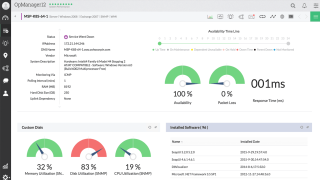2021 年適用於 Linux 的 5 個最佳 NetFlow 收集器

NetFlow 技術提供詳細的網絡流量分析。本文將探討最新的適用於 Linux 的 NetFlow 收集器。
IIS是Internet Information Services 的縮寫,以前稱為 Internet Information Server,是 Microsoft 的 Web 服務器,旨在與 Windows 產品(從 NT 系列開始)一起使用。
此 Web 服務器用於幫助 Windows 用戶在 Web 上託管各種類型的內容,例如媒體文件、文檔,甚至是成熟的網站。目前,Apache 是最流行的 Windows Web 服務器,其次是 IIS,令人印象深刻。
什麼是IIS?
IIS 是一種易於熟悉的 Web 服務器,這要歸功於其直觀的圖形用戶界面 (GUI),可讓您管理與服務及其相關用戶關聯的網站。IIS 的 GUI 使從一個位置設計、定制、配置和發佈網站變得容易。
它有一個稱為 IIS 管理器的內置網站管理工具,您可以使用該工具調整安全設置、性能參數、日誌記錄首選項以及您管理的網站的錯誤頁面或默認值等選項。
從技術的角度來看,IIS 非常通用,因為它可以提供標準和動態網頁,而無需付出太多努力。因此,您可以使用它來創建和發布 HTML 網頁,但很高興知道您還可以管理 PHP 頁面和 ASP.NET 應用程序。
由於其靈活性,IIS 可以運行包含在動態網頁中的腳本和應用程序,並將結果顯示到訪問者的 Web 瀏覽器屏幕上。對於靜態網站,這個過程更加簡單:IIS 只將 HTML 內容和圖像(如果有)發送到訪問者的 Web 瀏覽器。
IIS 的目的是什麼?
鑑於它受益於 Microsoft 的全面支持,並且它包含許多高級功能,因此 IIS 是創建和管理商業網站(例如電子商店或促銷組合網站)的絕佳選擇。
缺點是將 IIS 用於商業目的也意味著您需要商業許可證。此外,此許可證類型的價格取決於您要包含的用戶數量。
因此,我們已經確定 IIS 可用於創建和託管網站,以及它支持靜態和動態 Web 內容的事實。然而,IIS 遠不止於此。例如,您可以使用其內置模塊支持來增強服務器的功能。
可以在您的服務器上安裝流媒體模塊,以便您網站的訪問者可以從流媒體內容中受益。您還可以使用 URL 重寫模塊,該模塊使您能夠創建強大的 URL 實現規則,以便訪問者可以輕鬆記住它們並且搜索引擎可以更快地找到它們。
因此,不用說,如果您需要一種快速的方法來創建和發佈網站,IIS 是最好的方法之一。最好的方法仍然是 Apache HTTP,因為它是開源的,並且可以讓您免費使用它,而不管用戶數量如何。
IIS 版本歷史
值得一提的是,最初,IIS 旨在替代作為研究項目開發的 Web 服務器。第一個 Microsoft 簽名的網絡服務器項目作為免費軟件分發,專為 EMWAC(歐洲 Microsoft Windows NT 學術中心)設計。
然而,看到 EMWAC 服務器無法處理所有進入 microsoft.com 網站的流量,該項目被放棄,微軟開發了自己的 IIS 形式的 Web 服務器。
一個值得注意的方面是大多數版本的 IIS 都是與 Windows 操作系統版本一起發布的。果然,當時的 IIS 只是我們今天所知的影子;事實上,每個 Windows 版本都可以很好地作為 IIS 發展的檢查點。
如果您計劃使用 IIS,請嘗試堅持使用最新的穩定版本,因為它通常具有最嚴格的安全性並產生最佳的面向性能的結果,尤其是在您運行最新版本的 Windows 或 Windows Server 時。
如何安裝IIS?
正如我們之前所說,您不需要安裝 IIS,因為它實際上應該與您的 Windows 版本捆綁在一起。如果您使用的是 Windows 10,則您的 PC 上應該已經安裝了某些版本的 IIS 10.0。
但是,Microsoft 決定默認情況下不激活 IIS,因此您需要手動啟用它。但別擔心,完成這件事並不是什麼火箭科學。只需按照以下步驟在您的 PC 上激活 IIS:
現在您可能想要重新啟動您的 PC,以便您的系統可以加載所有必需的配置文件,並讓您充分使用 IIS。它也可以在不重新啟動 PC 的情況下工作,但在啟用新功能後重新啟動系統絕不是一個壞主意。
您還可以使用 PowerShell 在您的計算機上啟用 IIS。如果您從未聽說過,PowerShell 是一個複雜的工具,很多人將其誤認為是 CMD。PowerShell 比這複雜得多,但我們不會詳細介紹。事不宜遲,以下是使用 PowerShell 在 Windows PC 上啟用 IIS 的方法:
Enable-WindowsOptionalFeature –online –featurename IIS-WebServerRole如您所見,PowerShell 提示在您的 Windows 10 PC 上啟用 IIS 後無需重新啟動。如果要恢復該過程,可以使用以下命令通過 PowerShell 禁用 IIS:
Disable-WindowsOptionalFeature –online –featurename IIS-WebServerRole但是,請注意,要禁用此功能,即使 PowerShell 也建議您重新啟動 PC。也可以稍後重新啟動它,只是在此期間不要啟動任何新項目。
IIS 服務器是如何工作的?
首先,值得注意的是,IIS 有自己的流程引擎,可以處理所有客戶端-服務器請求。因此,每當客戶端向您的 Web 服務器發送請求時,IIS 都會處理該請求、生成回复並將其發送給客戶端。
從架構的角度來看,這個過程在兩個不同的層面展開:
正如我們上面提到的,您可以在內核模式中找到 HTTP.SYS。HTTP.SYS用於將客戶端請求轉發到應用程序池。每當客戶端與網站的 URL 交互,嘗試訪問該頁面時,就會啟動此請求轉發過程。每當發生這種情況時,HTTP.SYS 都會檢索客戶端的請求並將它們排入特定應用程序池的隊列。
請求轉發後,w3wp.exe(工作進程)加載ISAPI過濾器,然後單獨加載HttpRuntime.ProcessRequest,或者與 aspnet_isapi.dll 一起加載(如果它是 ASPX 頁面)。HttpRuntime.ProcessRequest的啟動標誌著處理的開始,之後HttpRuntime進程使用HttpApplication對象構建一個池,池中的內容將通過 HTTP 傳遞。
然後激活 HTTP 模塊,這個過程一直持續到請求到達ASP.NET頁面的 HTTP 處理程序。請求通過HTTP路由後,頁面開始顯示。
什麼是工作進程?
首先,值得注意的是,Worker Process 並不只有一個。事實上,有幾個這樣的實體可以確保您的 Web 服務器和您在其上託管的內容(無論是我們正在談論的網站還是應用程序)的良好運行。
因此,IIS 的工作進程負責為我們提供您之前在 IIS 中配置的所有應用程序和網站的執行環境。這些流程包含對上述服務的良好運行至關重要的幾條信息。
您可以使用 API 來檢索有關內存佔用或 CPU 利用率的信息。這些詳細信息可以幫助您密切關注 Web 服務器及其相關工作進程的整體健康狀況。
最後但並非最不重要的一點是,您可以使用 API 來終止工作進程,只需向工作進程端點發送DELETE請求即可。
什麼是應用程序池?
儘管名稱有些不言自明,但 IIS 應用程序池的用途要復雜得多。首先,應用程序池包含工作進程,因此可以肯定地說它扮演著容器的角色。此外,它將應用程序彼此隔離,無論它們是在同一台服務器上還是在不同的服務器上運行,這與池通常的工作方式相反。
知道一個應用程序池可以容納多個網站非常重要。因此,換句話說,您可以說應用程序池只是一組已由工作進程處理的 URL。這些池中的應用程序的分離是合理的,因為它可以顯著簡化管理。更重要的是,正是由於這種隔離,在一個應用程序池發生故障的情況下,其他應用程序池可以繼續照常運行。
如何配置IIS服務器?
您已經在您的計算機上啟用了 IIS 並且您已經了解了它的一些組件,現在讓我們看看如何正確配置它,以便您可以毫不費力地運行您自己的 Web 服務器。
正如我們之前提到的,人們使用 IIS 的主要原因之一是為了輕鬆部署 Web 應用程序。IIS 及其高級安裝程序功能允許您在多台服務器上配置和部署 Web 應用程序,而不會跳過任何一個節拍。您也不需要為每台機器創建新配置,因為 IIS 可以輕鬆處理這些。
如果您想配置一個新網站,您要做的第一件事就是前往文件和文件夾視圖,您可以在其中管理現有的應用程序文件或根據需要添加新的應用程序文件。請注意,考慮到您網站的管理面板稍後會使用它們,您需要將應用程序文件放在它們各自的目錄中。
處理完這些文件後,您可以轉到 IIS 服務器視圖,在那裡您可以使用“新建網站”工具欄來鍵入新網站的名稱。您接下來需要做的是調整您網站的HTTP/HTTPS設置,並考慮使用SSL來增加安全性。以下是為網站或文件夾配置 HTTP 和 SSL 的方法:
如何使用 SSL 保護 IIS Web 服務器?
SSL 是 Secure Sockets Layer 的縮寫,仍然是加密您與任何目標網站之間通信的最佳方式之一。還記得不久前許多網站從 HTTP 飛躍到 HTTPS 嗎?好吧,SSL 證書過去和現在仍然是這個過程的重要組成部分。
好消息是您可以使用 IIS 輕鬆地將 SSL 部署到您的網站。另一方面,您肯定必須購買證書,因為從數據加密的角度來看,它們是您的網站被認為值得信賴的唯一途徑。
因此,第一步是尋找 SSL 證書提供商併購買此類物品。購買後,您將收到代碼或證書文件。為了使用 IIS 配置 SSL,我們需要證書文件,因此請確保在繼續之前檢索它。
使用 SSL 保護 IIS Web 服務器
Now you’ve successfully installed a certificate for your IIS server. However, that’s not nearly enough, as you’ll still have to bind the certificate for your website. By the end of it, you’ll have a secure website with a certificate that’s associated with your website, port, and IP address.
Bind security certificate to the website
So we’ve managed to install SSL on your IIS web server and associate it with your website. You can use the steps above to associate certificates with more than just one website if the need arises. However, there’s still one thing we need to do: redirect incoming HTTP traffic to HTTPS, to ensure encryption of our visitors’ traffic.
Redirect HTTP to HTTPS
(.*) in the Pattern field{HTTPS} in the Condition input field^OFF$ in the Pattern fieldhttps://{HTTP_HOST}/{REQUEST_URI} in the Rewrite URL fieldThat’s it, you’ve now completely implemented SSL on your web server, bound it to your website, and configured the site to redirect incoming HTTP traffic to HTTPS. If done correctly, visitors who try to access your website using HTTP will be automatically redirected to its secure HTTPS counterpart.
What are Virtual Directories?
As we’ve established before, creating and managing a website isn’t the only thing that IIS is capable of doing. You can also create applications, which we already mentioned, but most importantly, you can create virtual directories by simply giving them a name that maps them to a physical directory.
The way this feature works is by letting users access various types of content that are hosted on a server quickly through a direct name. Surely enough, this content could be a website, but it could also be photos, videos, or other types of smaller media files.
Back in the day when IIS 6.0 was all the fuss, virtual applications, and directories were treated as separate objects by IIS. As such, applications consisted of the following elements:
Starting with IIS 7.0, virtual applications and directories are organized within a hierarchy, but they’re still considered to be separate objects. Thus, a website, which is higher in the hierarchy, can contain several applications, or virtual directories that are mapped to a physical location on your PC.
What are log files in IIS?
In IIS log files serve the same purpose they do wherever else you may encounter them. You can use these files to check how things unfolded on your web server, see important events, and, most importantly, understand where things went wrong if any malfunction occurs.
In other words, an IIS log file keeps tabs on everything that happens to your web server, in case you ever need it. A few examples of recorded data include the precise date and time of the events, how much data was transmitted, and the IP addresses related to the events.
Find log files on IIS 7.0 and later
Find log files on IIS 6.0 and earlier
Can I change ports in IIS?
IIS uses port 80 for all HTTP traffic by default, but that doesn’t mean you can’t change it to another value if you want or need to. Changing to a different port can help you avoid certain firewall-related connectivity issues or dodge attacks that target certain service-port vulnerability combos.
Change default port in IIS
Since IIS usually uses port 80 by default, there’s no need to specify it whenever you want to test your website’s functionality, for instance, from inside a browser. You just type your domain name and you should be able to access your website without a hiccup.
However, if you insist on changing the default port, you’ll need to specify it each time you’re trying to access your website from a web browser. You can do that by adding :port number (where port number is the actual port you’re using) at the end of your domain name.
If, for instance, we would change the port of our website to, let’s say 2609, accessing it would look like this: Tips.WebTech360.com:2609. Pretty simple, right?
Now if you’re using an older version of Windows, and implicitly an older version of IIS, there are a few things you’ll need to do in a different manner to change the default port.
Change IIS port on Windows 8.1
How can I monitor IIS?
If you’re not exactly a fan of keeping things in order through manual testing and checking log files frequently (we get you), you may want to consider leaning on third-party software solutions that could keep an eye on your IIS web server for you.
SolarWinds Server & Application Monitor
SolarWinds Server & Application Monitor is currently one of the best third-party utilities that can help you monitor your IIS website, server, application, or virtual directory without significant efforts. You just point it to the things you want to keep track of and let it work its magic.
Not only does this tool let you know if your websites and web servers are up and running, but it also provides you with an impressive range of key metrics, including but not limited to CPU, memory & disk usage, and response times.
Furthermore, if there’s something wrong with one of the websites you’re monitoring, SolarWinds Server & Application Monitor can automatically restart it for you in an attempt to fix the issue in a simple manner.
SolarWinds Server & Application Monitor’s screen is split into multiple sections, where you can monitor and analyze your applications and websites, access an overview of your applications’ health status displayed in graph form, and even manage applications at the press of a button.
You can also use this tool to keep track of your SSL certificates‘ expiration dates so that you can always be on top of things when it’s time to renew a soon-to-expire certificate. More so, you can use SolarWinds Server & Application Monitor to manage SSL certificates for several websites or servers for added convenience.
If you’re curious and want to give SolarWinds Server & Application Monitor a try, you’ll be glad to know that there’s a 30-day free trial available, so that you can test run its capabilities before committing to purchasing a license.
What is IIS – Conclusion
To wrap it up, IIS is a handy Microsoft webserver service you can use to create your own server, as well as manage websites, applications, and virtual directories in it without breaking a sweat. It’s currently the second most popular Windows web server in the world, losing first place to Apache HTTP, which is a completely free alternative.
IIS is mainly used to manage commercial websites, which requires you to purchase a commercial license. The price of such a license varies depending on the number of users you plan on having on the website.
Configuring IIS is somewhat intuitive, but you’ll need to be a bit tech-savvy to be able to make out all of its features, understand what each of them does and configure them to get the most out of your web server and associated websites or applications.
NetFlow 技術提供詳細的網絡流量分析。本文將探討最新的適用於 Linux 的 NetFlow 收集器。
儘管 Microsoft Access 如此流行且無處不在,但它並不是同類產品中唯一的產品。事實上,有多種替代方案可供選擇,並且
網絡管理軟件市場非常擁擠。按照我們推薦的最佳網絡管理工具來縮短您的搜索。
Ping 掃描可以通過多種方式為您帶來好處。請繼續閱讀,我們將討論如何操作並介紹您能找到的 10 種最佳 Ping 掃描工具。
網站很重要,必須不斷密切監控以獲得足夠的性能。以下是一些用於監控網站的最佳工具。
以下是一些最好的軟件部署工具,可以減輕管理任意數量機器的痛苦
如果您從事健康行業或以某種方式參與該行業的 IT,您很有可能聽說過 HIPAA。健康保險的便攜性
sFlow 是一種內置於眾多網絡設備中的流分析協議。我們回顧了前五名的最佳免費 sFlow 收集器和分析器。
為了幫助您選擇合適的工具,我們引入了最好的無代理基礎設施監控工具,並讓您快速查看每個工具。
隨著 Linux 在數據中心變得越來越流行,他們正在研究 Linux 上的帶寬監控,同時也在審查最佳工具。





